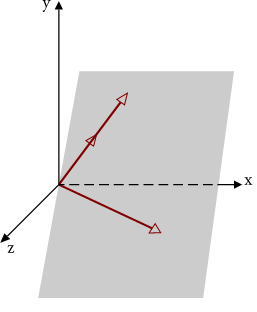Fifth Dimension Vector Maybe?
 a
−
1
+
2
b
−
4
+
3
c
−
9
+
4
d
−
1
6
+
5
e
−
2
5
=
2
a
+
b
+
c
+
d
+
e
a
−
1
+
2
b
−
4
+
3
c
−
9
+
4
d
−
1
6
+
5
e
−
2
5
=
2
a
+
b
+
c
+
d
+
e
Five real numbers a , b , c , d , e satisfy the equation above. Find a + b + c + d + e .
Image Credit: Wikimedia Linearly Dependent Vectors by Super Rad!
The answer is 110.
This section requires Javascript.
You are seeing this because something didn't load right. We suggest you, (a) try
refreshing the page, (b) enabling javascript if it is disabled on your browser and,
finally, (c)
loading the
non-javascript version of this page
. We're sorry about the hassle.
3 solutions
The last step follows from the Trivial Inequality and we get the following bounds (one from using CS and another from using the Trivial Ineq.):
( a + b + c + d + e − 1 1 0 ) 2 ≤ 0 ∧ ( a + b + c + d + e − 1 1 0 ) 2 ≥ 0 ⟹ a + b + c + d + e − 1 1 0 = 0 ⟹ a + b + c + d + e = 1 1 0
Just for clarification, you should mention that CS was performed on the following sequences:
{ a i − i 2 } i = 1 i = 5 and { i } i = 1 i = 5
, where { a i } i = 1 i = 5 ≡ { a , b , c , d , e }
Log in to reply
Thanks for pointing out.. This method struck me because I was practicing Cs problems yesterday..
how did u get the 2nd and 3rd step ?
It is rather simple put the terms of LHS andqtythat of RHS equal...that is sqrt(a-1) = a/2 And so on..... You will get a perfect square for a,b,c,d,e....find them and put them in the final equation
Same approach.as the independent elements on the LHS are related to individual elements on RHS,I equalled as u did,..I was hoping some formal solution would exist... ..
Put L.H.S. terms equal to corresponding R.H.S. terms and solve the equation to find values of a,b,c,d,e and find their sum
Using Cauchy-Schwarz inequality,
( ( a − 1 ) + 2 ( b − 4 ) + 3 ( c − 9 ) + 4 ( d − 1 6 ) + 5 ( e − 2 5 ) ) 2 ≤ ( a + b + c + d + e − 5 5 ) ( 5 5 )
⇒ 4 ( a + b + c + d + e ) 2 ≤ ( a + b + c + d + e − 5 5 ) ( 5 5 )
On simplification: ⇒ ( a + b + c + d + e − 1 1 0 ) 2 ≤ 0
But the above expression can only be equal to 0 and not less than 0 .
Hence a + b + c + d + e = 1 1 0